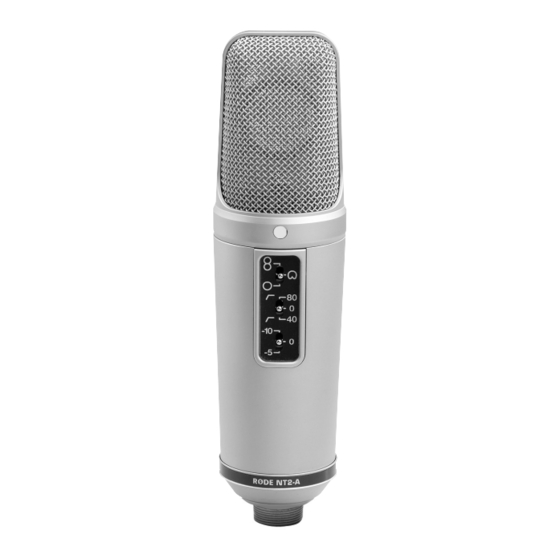Table of Contents
Advertisement
Quick Links
Download this manual
See also:
Instruction Manual
Advertisement
Table of Contents

Summary of Contents for RODE Microphones NT2-A
- Page 1 NT2-A Instruction Manual www.rodemic.com ( EMC, LVD )
- Page 2 NT2-A Multi-Pattern Large Diaphragm Condenser Microphone. The NT2-A carries on the tradition forged by the legendary NT2. It was recognised as the World’s Best Studio Microphone by the MIPA in 2006, in addition to being awarded the Electronic Musician Editor’s...
- Page 3 Specifi cations Acoustic Pressure, Pressure gradient Principle: Directional Three position variable - Omni, Pattern: Cardioid or Figure 8 (see graph) Frequency 20 Hz - 20 kHz Range: (see graph) Output 200Ω Impedence: Sensitivity: -36 dB re 1 Volt/Pascal (16 mV @ 94 dB SPL) +/- 2 dB @ 1kHz Equivalent Noise: 7dBA SPL (per IEC651)
-
Page 4: Frequency Response
Specifi cations Frequency Response 20Hz 1 0 0 1 00 0 10 00 0 20 000 Cardioid 20Hz 1 000 10 00 0 20 0 00 Omni Polar Response Cardioid Omni Figure 8 - 4 -... - Page 5 Features • Large 1” gold sputtered capsule • On-body control of polar pattern, HPF and PAD • Three position variable polar pattern - Omni, Cardioid or Figure 8 • Three position variable High-Pass Filter - Flat, 40Hz or 80Hz • Three position PAD - 0dB, -5dB or -10dB •...
- Page 6 • The gold dot on the face of the NT2-A indicates the front of the microphone, and the pick-up area of the cardioid pattern. Please be sure to have the side with the dot facing the sound source you wish to record.
- Page 7 Using the NT2-A • Microphone technique, or how to get the sound you want, requires experimentation. We suggest that you start with the channel EQ set to ‘OFF’ or ‘FLAT’ (no boost or cut). Try to get the sound you want by placing either refl ective or absorbent panels at various angles adjacent to the source being recorded.
- Page 8 Setting the Polar Pattern The NT2-A polar pattern can be adjusted to either omni, through cardioid or fi gure of eight. This fl exibility allows for more versatile recording of vocals, instruments and sound sources. After making a selection change, allow a few moments for the microphone to stabilise.
- Page 9 Setting the Polar Pattern • When in the omni position (lower position), the microphone picks up sound from all around the microphone and there is less proximity effect than in cardioid mode. (Proximity Effect is an increase in lower (bass) frequencies when the sound source is ‘close’...
- Page 10 The middle selector switch on the front of the NT2-A can be used to set the High-Pass Filter to 0Hz/Flat (center position), 40Hz (lower position) or 80Hz (upper position).
- Page 11 Settings Reminder You may wish to keep a record of the settings you have made during a recording. Should you wish to recreate a section of a recording, or to capture the same “sound quality”, you can refer to the manual and easily retrieve the mic’s previous settings.
- Page 12 Support If you experience any problem, or have questions regarding your microphone, fi rst contact the dealer who sold it to you. We have an extensive dealer network to assist you. If you have diffi culty getting the advice or assistance you require from the dealer, do not hesitate to contact us directly via the details below.

















Need help?
Do you have a question about the NT2-A and is the answer not in the manual?
Questions and answers